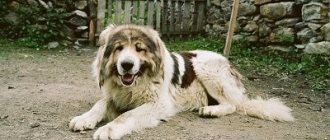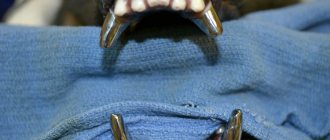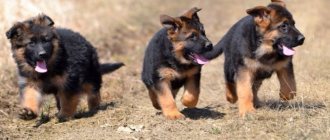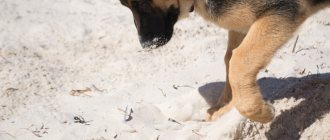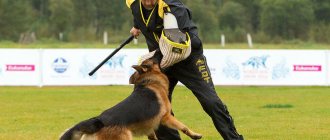During the entire gestation period, as well as during childbirth and the postpartum period, the owner must provide his pet with the necessary care. Only in this case will the puppies be born strong and strong. In addition, proper care will help maintain the health of the female. In order to provide all possible assistance to their pet, as well as to organize proper care for the offspring, many owners try to take leave during the period of childbirth. How long does a pregnant German Shepherd dog walk? How does the process of gestation and labor proceed? This article will answer these and other pressing questions in detail.
Pregnant German Shepherd
Rules for preparing for mating
A female German Shepherd reaches physiological maturity at the age of 6-9 months. However, it is not recommended to breed a female dog when she is in her first heat. Experienced breeders advise mating at the time of the dog’s third sexual cycle.
When pregnancy occurs earlier than expected, the risk of sick or dead puppies being born increases.
When preparing for mating, the search for a male dog should be carried out by the owner of the bitch. The choice of candidate is determined by several factors:
- breed;
- lack of family ties with the female (if there are even distant ties, puppies can suffer from congenital diseases).
The preparatory stage should begin a month before the process. During this period, dogs must undergo deworming. It is also necessary to eliminate skin parasites and get preventive vaccinations.
Experts recommend breeding dogs only through a breed club or kennel. In this case, breeders independently select a healthy pair for the female.
Attention! Mating with an unfamiliar and untested male can lead to infection with parasites and transmission of sexually transmitted infections, which, in turn, will provoke the development of other pathologies.
Daily routine and feeding of the puppy
A German Shepherd puppy is easy to train. In order for him to grow healthy and strong, he must walk and eat at the same time. The walking time increases every month. Ideally, a German Shepherd should spend 3 to 5 hours a day outside. During the day, you should choose a time for classes. The animal must work, even if it lives in an apartment and is an ordinary civilian dog. To work means to carry out commands.
Walks should be started only after vaccination has been carried out according to all the rules: after 1 vaccination, 10 days pass, then repeated vaccination is done, and again 10 days of quarantine. All this time the puppy should be at home, since during this period he is most susceptible to diseases.
Don't forget to give your dog deworming medications. Parasites from wool should be removed regularly using special means. In the future, it is best not to wait for them to appear, but to put on a permanent anti-parasitic collar for the dog or treat the fur with special means as a preventive measure. Ears should also be cleaned regularly.
A shepherd puppy should be fed according to the following schedule (per day):
- up to 2 months – 6 times;
- up to 4 months – 4 times;
- up to 6 months – 3 times;
- after 6 months – 2 times.
It is important to monitor the calcium content of your animal's food. A distinctive feature of German Shepherd puppies is their rapid growth from 3 months to 6 months. At this time, they gain the height and weight of an almost adult dog. If a male dog should be 65 cm at the withers, then a puppy gains 55 cm in six months. Such rapid growth is impossible without proper nutrition and supplying the body with calcium. Therefore, dogs at this age often have dysplasia - weak joints. And with a lot of weight, this causes severe pain to the puppy, he stops walking. The disease is treated by intensively feeding the body with necessary substances.
The German Shepherd's diet includes head meat, offal, and poultry. You can give fish, but only without bones and boiled. The dog willingly eats various porridges: rice, millet, oatmeal or buckwheat. You can diversify the menu with crackers. Another distinctive feature of the German Shepherd is its unpretentiousness in food. A dog can eat the same dish for years without getting tired of it. You just need to please him sometimes with biscuits and fresh fruit.
In the modern world, especially in big cities, it is customary to feed your dog dry food. An experienced veterinarian will help you understand the huge variety of products offered. He will also suggest a dry food feeding plan.
To prevent your puppy from suffering from constipation and diarrhea, baked goods, legumes, pasta, smoked meat and fish must be excluded from his diet. After eating, especially if he eats dry food, you need to give him fresh water to drink.
Food should not be hot or too cold; it should be served in a special bowl in a permanent place. From childhood, a puppy must be taught to eat only in its place and only from the hands of its owner. We need to teach him not to pick up food from the floor. Someday this science will save his life, because it is known that rat poison disguised as food can be scattered along the city streets.
Signs of pregnancy
Pregnancy in a German Shepherd can be determined by the following signs:
- Changes in character that are observed already in the first month. Aggression, playfulness, apathy, etc. are possible. It is possible to accurately determine whether the female is pregnant at this stage only with the help of an ultrasound.
- By the end of the first month, body weight increases.
- On day 30, the mammary glands swell and change color (become darker). The dog's appetite increases.
- The belly gradually grows and falls. At first, the bitch may simply seem fatter, but by the end of the term, during a multiple pregnancy, the belly becomes swollen, acquiring a pear-shaped shape, and droops.
- At week 6, an ultrasound will help determine the number of future puppies.
- At week 7, the female becomes noticeably rounder. Hair falls out around the nipples.
- At 9, discharge from the loop appears and colostrum is formed.
On a note! During a normal pregnancy, it is almost impossible to detect external signs in the first month.
Diagnosis, signs of pregnancy
Ultrasound of puppies
At the beginning of pregnancy, it is almost impossible to establish pregnancy without hardware diagnostics. Signs become obvious starting from the 5th week - even inexperienced dog breeders can easily detect changes (enlarged abdomen, swelling of the mammary glands).
To establish the exact fact of pregnancy in the early stages, you will need a diagnosis at a veterinary clinic. An ultrasound can reveal an interesting position as early as the 4th week.
The veterinarian will establish the fact of pregnancy and assess the condition of the future offspring, but he will not be able to name the exact number of puppies. This information can be obtained only on days 48-50 using an abdominal x-ray.
An ultrasound is also mandatory if the pet’s condition worsens sharply (the dog refuses to eat, it often vomits, and depression is observed). Diagnostics will allow you to assess the condition of the fetus. If hypoxia or frozen pregnancy occurs, the dog will need immediate medical attention.
False and frozen pregnancy
A sign of a false pregnancy is the appearance of milk at 5 weeks after estrus and a sharp change in behavior. This condition is a consequence of hormonal imbalance. It happens that symptoms occur later, for example, 2 months after estrus.
If mating has taken place, then the cause of a false pregnancy may be the death and resorption of the fetus in the first month.
This is interesting! Some females have a genetic predisposition to this pathology. In this regard, they can even feed other people's cubs.
Symptoms of false pregnancy:
- swelling of the mammary glands, appearance of milk;
- enlargement and swelling of the loop;
- change in appetite (decrease or increase);
- toxicosis;
- increased body temperature;
- pseudo-contractions are possible;
- the dog refuses to walk, looks for a secluded place, behaves restlessly, whines;
- the bitch becomes apathetic;
- the female begins to set up a den, “babysits” inanimate objects, and can behave aggressively, defending the nest;
- The dog exhibits maternal instinct towards other pets.
This condition is not a disease in the usual sense, it is a complex psychophysical disorder caused by hormonal imbalance, as well as psychological factors (for example, a dog living together with a pregnant female).
However, such a condition is dangerous due to such consequences as:
- Purulent mastitis.
- Tumors in the uterus.
- Stress.
It is recommended to show the dog to a veterinarian.
As for frozen pregnancy, it consists of the following: the development of one or more embryos stops, as a result of which they quickly die.
Attention! The problem can be caused by hormonal imbalances, infectious diseases, developmental pathologies, etc.
Diagnosis is carried out on the basis of the clinical picture and as a result of ultrasound. Dead fetuses are most often expelled from the uterus on their own, resulting in a miscarriage.
Average gestation time
It is not possible to determine exactly how long pregnancy lasts in German Shepherd dogs, since this period varies among different bitches and also depends on the number of fetuses. On average, German Shepherds are expected to bear puppies for 60-65 days.
In addition, there are several patterns:
- Firstborns have a longer pregnancy.
- The more fetuses, the earlier labor occurs.
Premature birth (before 53 days) causes puppies to become unviable. With a prolonged pregnancy (more than 70 days), the dog needs surgical intervention.
Important! The owner must make notes about how many days after mating the birth occurs. In the future, this will allow you to avoid medical intervention in cases where it is actually not necessary.
For example, if a pet manages to carry puppies for 70 days, and the puppies are born healthy, a cesarean section will not be necessary.
Errors in determining how long dogs (pregnant shepherd dogs) walk often arise due to the fact that the beginning of pregnancy is counted from the date of mating. However, it is important to remember that these points do not always coincide. Usually the time interval between them is several days. Thus, fluctuations in the duration of gestation are explained by the gap between the date of mating and the beginning of the ovulation period.
Gestation lasts approximately 2 months
The puppy is one and a half months old.
Next, we will consider changes in the exterior and character of the puppy depending on its maturation. If you buy a German Shepherd puppy at the age of about 1.5 months, he is harmonious, compact and not too different from his sisters and brothers. At this age, puppies are all very similar to each other, especially littermates. That is why it is recommended to choose a puppy for breeding at a later age, when each puppy begins to show its own advantages and disadvantages.
The German Shepherd puppy is two months old.
At 2 months the puppy is already quite large. Most puppies at this age begin to increase in size, ears, paws, and tail. By the age of three months, owners of a puppy who adopted a “German” for the first time often ask me questions and worries about the fact that “the puppy’s paws seem too long and large, he himself is clumsy and disproportionate, and his tail has grown very long.” At this age, the puppy is at its best and cutest. It is quite normal for a puppy at this age to develop huge joints on his front legs, his hind legs to become elongated and held like flippers, and his tail to be long and carried low to the ground. These signs are features of the development of the breed, indicators of the strength of its skeleton and characteristics. Gradually this will become less noticeable, by about 5-6 months.
Character of a German Shepherd puppy at 2-3 months.
As for the character of a puppy at the age of 2-3 months, the puppy is mobile, active, full of energy and ready to play and try everything he comes across. In addition, during the post-vaccination quarantine period, the puppy is kept in the house and is not taken outside, so he “splashes out” all his energy on everyone who lives in the house with him. Gradually, after the puppy begins to walk and explore the world, he will have more impressions and will no longer be interested in chewing furniture or messing with the house, although while the puppy is young and active, mischief can be expected from him.
Stages of an interesting situation
The main gestation periods have the following characteristics:
- First stage. Occurs during the 4th week of pregnancy. There are no obvious external changes, with the exception of lethargy and a feeling of thirst. By the end of 2 weeks, the embryos are attached to the wall of the uterus. By the 21st day, the heart has formed in the fetuses, the body size does not exceed 0.5 cm. On the 27-28th day, the body is formed (no hair), the skull appears, the size of the future puppies is 2 cm.
- Second phase. Includes 4-6 weeks. A consultation with a veterinarian is required to determine the number of fetuses. On day 32, the body weight of the fetus reaches 25% of its full value. On day 37, the formation of organs and organ systems is completed. From day 34, the bitch’s belly begins to grow and her appetite increases.
- Third stage. Lasts for 6-7 weeks. At this stage, in addition to internal organs, the fetuses have formed eyes, bones of the spine and fingers. Body size reaches 6.5 cm.
- Fourth stage. Accounted for 7-8 weeks. At the end of the 7th week, obvious movement of the fetuses in the uterus is observed. The weight of the fetus is 75% of the weight at birth, the body size reaches 12 cm by the 50th day.
- Fifth stage. Includes 8-9 weeks. The stomach drops, appetite disappears, the dog drinks a lot and urinates often (the fruits put pressure on the bladder). Puppies grow up to 15 cm. By day 60, the cubs are covered with fur and are ready to be born.
- A few hours before birth, body temperature drops slightly and breathing becomes heavy. From now on, you should expect childbirth in the near future.
What does it look like?
Newborn
Puppies in the first month of life all look the same. They have a pointed, elongated muzzle, with a large black nose.
Each puppy has short, shiny fur. Each of them weighs from 350-500 grams. The more puppies are born, the less the weight of each of them.
Description by month
When the baby turns one month old, characteristic differences appear:
- Size : from 18 – 21 cm.
- Body : The back is short and the chest is wide.
- Paws : against the background of the body they look very large, there is also no dewclaw.
- Weight : ranges from 3 to 4.5 kg.
- Eye color : dark brown, but in rare cases the color can remain blue for up to two months.
- Ears: soft and large, can hang up to 6 months.
- Teeth : There is a scissor bite on the front teeth.
- Coat : hard, thick undercoat has appeared.
When puppies reach 2 months of age, their paws and tail grow very much. Bones are formed in 28-30 days, but by the second month they are still very fragile.
The puppy becomes stronger in build by the 4th month, and the joint bumps are also very prominent.
If compared with a newborn puppy, by 6-7 months the size increases 7-8 times. The head becomes very large. At the age of 6 months, growth stops and muscle mass increases.
From 9 to 12 months, the young shepherd will rapidly gain weight. The muscles actively develop and the bone skeleton is finally strengthened. Growth stops, if it subsequently increases, it will be no more than 2-3 cm.
Below you can see photos of puppies aged 1, 2, 3 and 4 months, including black ones.
Caring for a pregnant female
A dog is considered pregnant after mating, and there is no need to change diet or exercise in the first month. In the future, you will need to select appropriate feeding, organize walks according to the new regime, and provide assistance in case of toxicosis. During the entire period, the dog should be handled very carefully.
After the first month of gestation, walks should become longer and calmer. A pregnant female is prohibited from jumping, playing with other dogs, or jumping over barriers. Since overheating is possible in hot weather, walking with your pet is allowed only early in the morning and in the evening.
Important! When wounds appear, it is necessary to disinfect problem areas with antiseptics. If purulent inflammation occurs, antibiotics will be required, the use of which is undesirable during pregnancy. If you feel unwell, you should immediately contact a veterinarian.
Box for a woman in labor
Possible difficulties
Caring for a puppy dog usually does not cause any particular difficulties, since pregnancy and childbirth in German shepherds is quite easy. However, against the background of certain negative factors (reduced immunity, stress), difficulties may arise:
- frozen pregnancy;
- miscarriage, often caused by brucellosis. Also, a provoking factor may be poor-quality nutrition, abdominal injuries, poisoning;
- ectopic pregnancy (usually due to hormonal imbalances);
- mastitis;
- hinge ruptures, microcracks.
Mastitis in a dog
Feeding a pregnant dog
In the second half of pregnancy, food should be 1.5-2 times higher in calories than usual. When feeding natural products, you must adhere to the following conditions:
- do not give your dog expired, low-quality products;
- boil meat and fish well;
- exclude soups and cereals;
- do not feed black bread, potatoes and other foods that cause bloating;
- It is recommended to consume lean meat, offal, cottage cheese, rice, buckwheat, and boiled vegetables;
- Vitamin and mineral supplements are required.
If your pet is kept on industrial food, then you should purchase products for puppies up to 2 months.
Starting from the 3rd week, the dog is fed 3 times a day, from the 7th week - up to 4 times a day.
Help with toxicosis
Nausea and vomiting can be relieved with fish and curd. In addition, special drugs in small dosages will be appropriate. They are prescribed by a veterinarian. In case of severe vomiting, it is recommended to add a small amount of glucose to the water.
Vaccination during pregnancy
Veterinarians advise against vaccinations during pregnancy and vaccination after birth. However, if the pet lives in a place where zoonotic diseases are common, vaccination of puppy dogs using high-quality complex preparations is allowed. They can be used during the first 20 days of gestation.
Important! It is prohibited to vaccinate weakened or sick animals. For this reason, toxicosis is a contraindication to the procedure.
Vaccination during pregnancy is highly undesirable
Height and weight (basic standards)
The dog's height is measured from the highest point at the withers to the ground vertically.
Ideal size:
- male 64-65 cm;
- female 57-59 cm.
Deviations in one direction or the other are allowed: 1.5-2 cm.
Ideal weight:
- male weighs from 30 to 40 kg;
- the female weighs from 23 to 33 kg.
The body length of a German Shepherd should be slightly greater than the height at the withers.
Ideal length:
- male from 71 to 77 cm;
- female from 61 to 70 cm.
Now let's look at the changes in the puppy's height and weight as it grows in more detail.
How does childbirth go?
Labor is the physiological process of removing fetuses from the uterus, expelling placenta and fetal fluid as a result of contractions (active muscle contractions of the uterus, repeated periodically) and pushing (rhythmic contractions of the abdominal muscles).
Childbirth can be divided into several stages:
- prenatal stage (preparatory);
- main process;
- postpartum stage.
whelping bitch
How to prepare for childbirth
The most important thing is to arrange a suitable place. The pet should give birth at home. The optimal temperature varies from 25 to 28 degrees. Drafts are not allowed. To create a cozy corner, you can use a box with high sides and insulate the bottom with blankets and diapers. For future puppies, a separate box will be required so that the mother can rest. In this case, the house for the babies should be within sight of the female.
You also need to prepare:
- clean towels;
- sterile wipes;
- cotton wool;
- syringes;
- antiseptic;
- medical vazil;
- oilcloth;
- heating pad;
- scissors;
- threads;
- iodine;
- medical gloves;
- scales.
Before childbirth, the vagina is treated with a weak solution of furatsilin.
Attention! Before you start giving birth, you need to cut your nails short, wash your hands thoroughly and treat them with alcohol.
How many puppies does a shepherd dog give birth to?
The number of cubs depends on the condition of the dog and its age:
- young females give birth to no more than 3 puppies;
- more experienced dogs give from 5 to 7 puppies;
- Large shepherd dogs can give birth to up to 10-12 babies.
Signs of imminent labor
The first symptoms appear 2-3 days before the onset of labor - the dog becomes restless, body temperature drops by a couple of degrees. Before the process itself, signs are observed:
- Breathing is intermittent, frequent.
- Accelerated heart rate;
- Dilated pupils.
- The dog asks the owner for help (whines, looks into the eyes).
- The mucus plug peels off.
- The pet arches its back and squats.
Prenatal period
At this stage:
- the muscles of the sacrum relax, the stomach drops;
- areas around the nipples become bare;
- clear mucus is released from the loop;
- symptoms of early labor occur (low temperature, etc.);
- The dog often licks the labia.
Main process
This stage begins with the release of amniotic fluid and ends with the removal of the fetus. The process is accompanied by contractions and pushing. The dog lies on its side, stretches its legs, and pushes.
One puppy emerges after 5-10 minutes. The baby is born in a bubble. The mother tears the film, gnaws the umbilical cord and licks the baby. Puppies are born at intervals of 15 minutes to 2 hours. Labor can last for 3-12 hours.
Dog behavior immediately after birth
Immediately after giving birth, the dog is surrounded by puppies and tries to protect them. In some cases, a phenomenon called “postpartum tetany” occurs:
- nervous behavior, frightened state of the female;
- refusal of food;
- rapid breathing;
- excessive salivation;
- spasms of paws and body;
- the dog often leaves the puppies unattended.
In this case, you will need the help of a veterinarian. The pet needs to be covered and a heating pad applied to it.
What to do after childbirth
After the puppies are born, you need to do the following:
- wash the dog's fur;
- take your pet for a walk, wearing a special apron;
- after a walk, wipe your paws and belly;
- change the bedding in the box;
- weigh the puppies and examine them carefully;
- change bedding for newborns daily;
- During the first 24 hours, you need to ensure that the bitch does not bite the babies or crush them;
- make sure that the puppies are well-fed and are close to their mother;
- feed your dog nutritious foods high in calcium and protein;
- give plenty of fluids;
- immediately after giving birth, give the shepherd a warm, not very fatty meat broth;
- if the bitch has not freed the puppies from the membranes on her own, the owner must do this for her as soon as possible, then remove the mucus from the mouth and nose, bandage and cut the umbilical cord;
- massage the babies with a clean and dry towel;
- It is important not to allow your dog to eat more than two placentas (otherwise it will cause diarrhea).
Newborn German Shepherd puppy
What to feed your dog after giving birth
After giving birth, the pet should be given warm boiled water or low-fat broth to drink. After a few hours, you can feed the dog cottage cheese.
During the first month, the diet should include low-fat milk, chicken eggs, rice, buckwheat, liver, and cottage cheese. If the shepherd dog was kept on industrial feed, experts recommend switching it to natural food (at least for the first time).
Formation and growth
A good, healthy, properly developing puppy should not grow anyhow. There is a certain pattern.
Let's take a closer look at all the stages of development of the German Shepherd.
The first stage is the intrauterine period. It is advisable to choose a puppy with a good pedigree in advance. It is necessary that mom and dad are healthy. Since it is now that the characteristics of the future baby are being laid;
The second stage is from birth to one and a half months. The puppy is still with the breeder. After birth, he quickly gains weight, doubling in the first week, tripling in three weeks;
The third stage is from one and a half months to six months. Active growth is taking place. Within thirty days, the pet's weight increases fivefold. Rapid growth occurs until about 4 months. The larger the puppy, the slower the growth rate. Here you need to be extremely careful, since the risk of osteoarticular diseases is the most dangerous. For about six months, it is necessary to regulate the daily diet in order to prevent the puppy from gaining too much weight. It is necessary to be very clearly aware of the enormous responsibility for future development that lies with the new owners, that is, with you. Carefully follow the basic instructions and tips described in this article;
The fourth stage is six months to two years. By six months, the puppy gains almost half the weight of the future adult dog. And it has been growing stronger for two years. By this point, growth has slowed down significantly, but the puppy’s weight continues to increase;
The fifth stage is the formation of a young dog. Growth has actually stopped, muscle mass continues to gain.
It is extremely important to keep track of how big your dog is and how much he weighs at each stage of his life cycle.
It is worth noting that the weight of an adult German of large and small breeds has a big difference: 70 times, while at birth the difference in weight is only 5-7 times. This means that a large breed German Shepherd puppy grows faster than a small breed dog.
There are two growth phases for puppies (large breeds):
- intensive growth – the period of skeletal formation;
- a significant slowdown in growth - muscle mass building.
The skeletal system develops in about twenty to eighty days. Muscle mass builds up over the course of three years, when the dog reaches its “adult” weight.
Do not forget that each German Shepherd puppy is individual, with its own characteristics. Therefore, be brave and never despair if your dog does not meet the standards, because these are just approximate parameters.
Caring for newborn puppies
It should be understood that newborn puppies are born deaf and blind. The normal weight of cubs is 300-500 g.
Caring for babies is a lot of trouble: the owner must provide comfortable and safe conditions for the normal growth and development of puppies.
Weighing a newborn puppy
Important care points
The owner must provide the following conditions:
- place the birth unit with the babies in a room where the air temperature is 28-30 degrees;
- wash and disinfect the bedding daily;
- puppies need to have their dewclaws removed;
- ensure that the cubs are well-fed;
- babies should eat mother's milk at least 12 times a day (in the first week), up to 8 times in the second week, up to 4-5 times in the third;
- In no case should puppies' eyes be artificially opened (this is a natural process - the opening of the eyes and the appearance of hearing occurs 12-15 days after birth;
- trim puppies' nails at least once a week;
- starting from 2 weeks of age, young animals need to be fed with porridge, from 3 weeks - given cottage cheese, rice water;
- Weaning from the mother should occur no earlier than 2 months.
Healthy young female German Shepherds tolerate pregnancy and childbirth quite easily. However, for this, the owner must provide appropriate conditions and properly care for his pet.
Feeding, diet
For proper, full development, it is important not to artificially interrupt the process of milk feeding of the chicks. It ends by 6-8 weeks of life. Milk is not only a nutritious product for a growing body. Colostrum helps strengthen the animal's immunity.
Milk itself promotes proper blood circulation and sufficient saturation of the body's cells with oxygen. You cannot replace it with goat or cow milk - the puppy may have a severe allergic reaction. If a kitten is weaned from its mother early, it is prescribed artificial milk developed according to a special formula.
By the 8th week of life, milk is completely removed from the kitten’s diet. Further feeding with it can lead to problems with the gastrointestinal tract. The animal is transferred to special food for German Shepherd puppies. It differs from adult food in its high calorie content, high content of calcium, fat, and protein. It is best if your veterinarian recommends a feeding schedule.
Another feeding option is natural food. This is natural dog food, an opportunity to feed your pet with quality products and create an individual menu for him. But feeding a dog naturally takes a lot of time: the owner will have to prepare fresh meals for the shepherd dog every day, independently calculate the KBZHU, and periodically purchase a variety of products. Puppies at this age can be offered:
- beef, veal;
- eggs:
- chicken fillet, offal (hearts, liver);
- buckwheat, rolled oatmeal, oatmeal, rice porridge;
- fermented baked milk, yogurt;
- grated apples and carrots, baked vegetables.
Each meal is 600-800 g of food. The transition from milk to natural feeding is smooth - every day the owner increases the share of meat, vegetables, and cereals.
The animal's diet should not contain:
- fatty meats and fish;
- sausages, canned food for people;
- bones;
- bakery products;
- stone fruits and berries;
- sweets, chocolate and other sweets;
- legumes;
- potatoes;
- spices, salt, herbs.
During the first feedings, food must be moistened and softened. The puppy is given 24/7 access to a bowl of fresh water. By the end of the 2nd month of life, the dog is gradually transferred to completely dry food. For all types of nutrition, shepherd dogs are recommended to take vitamin supplements, especially in spring and autumn.
At 2-4 months, puppies need to be fed 4-5 times a day - according to a predetermined schedule, at strictly defined hours. Young dogs are immediately taught discipline: one meal takes 10 minutes. Whether the puppy managed to eat all the contents of the bowl or not, after the time has elapsed, the plate with food is removed.
Adherence to a strict feeding schedule contributes to the development of discipline in a German Shepherd and is part of its upbringing and intellectual training. This is a preparatory stage for more meaningful and complex classes.


